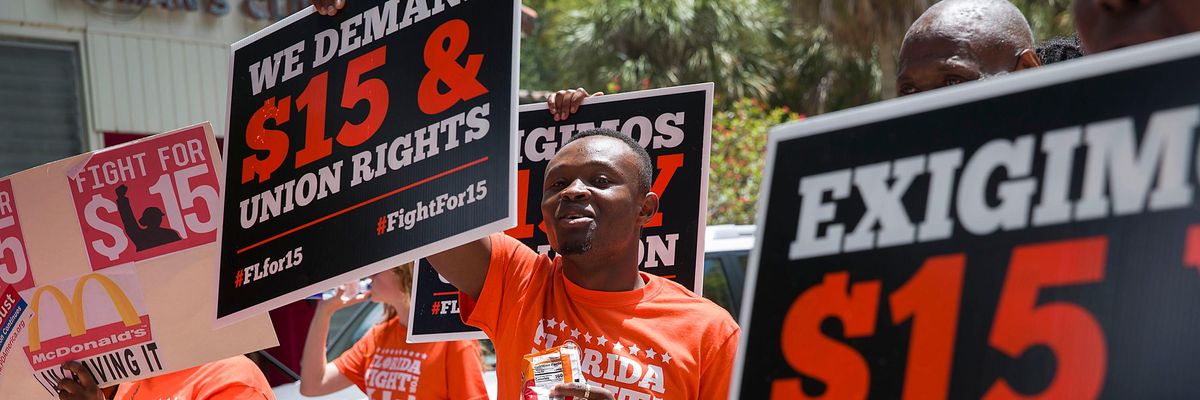Ten years ago, two hundred New York City low-wage workers walked off their jobs at McDonald's, Burger King, and other fast-food restaurants to demand what most observers thought impossible: 15 bucks an hour and a union.
Living costs were soaring then, much as they are today. Rents and healthcare expenses were increasingly out of reach and the federal minimum wage had not budged in three years (spoiler alert: it still hasn't). While taking home a mere $7.25 per hour to sustain some of the richest corporations in the world, these cooks and cashiers said they would have to earn more than double that to support their families without relying on public assistance.
By joining together, speaking up, and going on strike, fast-food workers in the Fight for $15 and a Union rewired the politics of wages in the country.
"I'm protesting for better pay," KFC worker Pamela Waldron told The New York Times after walking off the job. "I have two kids under 6, and I don't earn enough to buy food for them."
The National Restaurant Association dismissed that 2012 strike as a publicity stunt. Elected officials called the proposal a non-starter. Even many folks within the labor movement at the time thought $15 an hour was too bold an ask. Early on, leaders in the campaign asked me to convene a call of progressive economists who could vouch for $15 as sound economics. I struggled to gather a quorum.
But that cold November walkout--by far the biggest worker action in the history of the fast-food industry--launched a movement that would prove the skeptics wrong.
Over the past decade, the Fight for $15 has advanced a new model for change grounded in the power of grassroots organizing. Led largely by people of color, the movement has shown that to effectively challenge the stranglehold of the neoliberal political economy, interventions must come from the bottom up, reflecting the genuine voices of workers and their communities.
That first walkout may have taken people by surprise, but by April, workers in Chicago joined in. And then St. Louis and Detroit and Milwaukee and Seattle and Kansas City. By August, the movement had spread to 60 cities. A year after that, it reached 150 cities. By its fourth year, the Fight for $15 had expanded to include airport employees, home care aides, childcare workers, and adjunct professors.
Cities like San Francisco and Seattle began racing to adopt $15 an hour laws, with big states like New York and California soon to follow. Fifteen wasn't just popular in blue states: in 2020, voters in Florida backed $15 even as Donald Trump sailed to victory in the state; and in the recently concluded midterms, Nebraska voters passed $15 at the same time they elected three Republican House members and a Republican governor. As the national consciousness grew more attuned to the injustice of income inequality, the U.S. House of Representatives approved a federal $15 per hour minimum wage raise.
By joining together, speaking up, and going on strike, fast-food workers in the Fight for $15 and a Union rewired the politics of wages in the country. As more and more places adopted $15 minimums and the sky didn't fall, the economists who started off so skeptical started to get on board. Soon, politicians were racing to join workers on the picket lines. In 2015, the Democrats adopted $15 as part of the party's official platform. A Bloomberg headline from the 2020 presidential primaries noted that McDonald's strike lines had become "required campaign stops" for Democratic candidates.
This is what democracy looks like: bottom-up social movements with the vision and numbers to demand change. Workers in the Fight for $15 and a Union have the receipts to prove it: some 27 million have seen their paychecks increase by a collective $150 billion over the past 10 years, according to the National Employment Law Project. Roughly 43% of U.S. workers are on their way to making $15 per hour or more.
The only problem with waging a decade-spanning campaign for fair wages is that the baseline is always shifting. While economists and politicians and labor experts have gotten on board, the economy has changed. The pandemic exposed how reliant Americans are on underpaid essential workers, as well as the disproportionate harm they suffer when crisis hits. Now, inflation has soared to its highest level in 40 years and $15 an hour is no longer enough.
The good news is we have the tools and the momentum to do more. Unions have attained their greatest popularity in decades. Workers all over the country are demanding unions at once-unthinkable giants like Apple, Starbucks, and Amazon. Earlier this month, hundreds of service workers across the south joined together to launch the Union of Southern Service Workers, pledging to fight for higher pay and a seat at the table in a region of the country with the lowest union density in the nation. In California, half a million fast-food workers won a seat at the table following two years of pandemic-era protests when Gov. Gavin Newsom signed the Fast Recovery Act on Labor Day.
The boldness, vision, and solidarity of today's workers is palpable--and so are their critiques of massive income inequality, chronic student debt, inaccessible healthcare, and more. Since 2012, the consensus has shifted on how much one needs to make in order to live and save for the future. And more and more, workers are demanding unions as the solution.
In this age of innovation, the true disruptors are those who can turn pie-in-the-sky fantasies into reality. Workers in the Fight for $15 and a Union have shown what's possible when they organize. Now, let us dare to imagine what's possible in the next 10 years.

